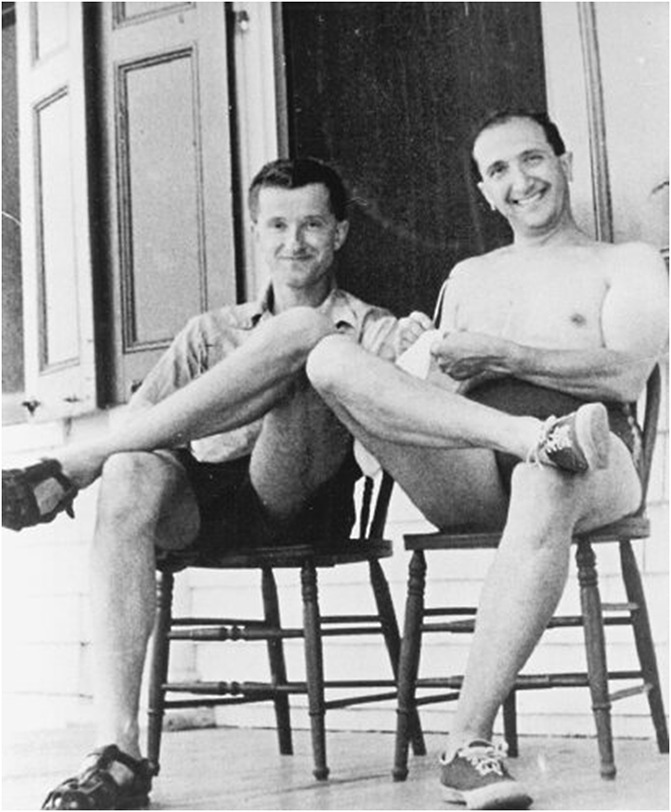
Do mutations arise randomly over time? Or are they induced by unfavorable environments? By addressing these crucial evolutionary questions, Salvador Luria and Max Delbrück won a Nobel Prize and helped to start the field of bacterial genetics.
In 1943, it had long been known that bacterial cultures rapidly develop resistance to viral infection. Some biologists argued that viruses directly induced resistance mutations, while others believed the mutations arose spontaneously before exposure to the virus. But when Luria and Delbrück first attempted to distinguish between these two hypotheses, they were frustrated by what appeared to be irritatingly inconsistent mutation rates. Then, after watching a colleague win a jackpot ($3 in dimes!) at a slot machine, Luria realized this inconsistency was telling him something: the number of mutant bacterial colonies present at the end of the experiment depended on when the mutations arose. Mutations arising in earlier generations would be present in many descendent cells (a “jackpot”), whereas mutations occurring in later generations would be present in only a few cells.
Luria passed his insight to Delbrück, who worked out the expected statistical distribution of the number of mutant cells per culture. Their data decisively rejected the hypothesis that bacteria became resistant only after being exposed to the virus and strongly supported the prediction that the phage-resistant mutations had a constant probability of occurring in each cell division.
The Luria–Delbrück article had three important impacts beyond its direct conclusion: it showed that elegant statistical analysis could illuminate biological processes that could not be directly observed, it contributed to Luria and Delbrück winning the 1969 Nobel Prize in Medicine or Physiology (shared with Alfred Hershey), and it led, indirectly, to a continuing debate about whether organisms exert physiological control over their mutation rates.
Footnotes
ORIGINAL CITATION
Mutations of Bacteria from Virus Sensitivity to Virus Resistance
Salvador Edward Luria and Max Delbrück
GENETICS November 20, 1943 28: 491–511
Image of Max Delbruck and Sal Luria at Cold Spring Harbor Laboratory, 1953. Courtesy of Cold Spring Harbor Laboratory Archives.
Communicating editor: C. Gelling
Further Reading in GENETICS
- Bertani G., 1992. Salvador Edward Luria (1912–1991). Genetics 131: 1–4. [DOI] [PMC free article] [PubMed] [Google Scholar]
- Cairns J., 1998. Mutation and cancer: the antecedents to our studies of adaptive mutation. Genetics 148: 1433–1440. [DOI] [PMC free article] [PubMed] [Google Scholar]
- Cairns J., Foster P. L., 1991. Adaptive reversion of a frameshift mutation in Escherichia coli. Genetics 128: 695–701. [DOI] [PMC free article] [PubMed] [Google Scholar]
- Fischer E. P., 2007. Max Delbrück. Genetics 177: 673–676. [DOI] [PMC free article] [PubMed] [Google Scholar]
- Foster P. L., 1998. Adaptive mutation: Has the unicorn landed? Genetics 148: 1453–1459. [DOI] [PMC free article] [PubMed] [Google Scholar]
- Fox M. S., 1998. Some recollections and reflections on mutation rates. Genetics 148: 1415–1418. [DOI] [PMC free article] [PubMed] [Google Scholar]
- Lang G. I., Murray A. W., 2008. Estimating the per-base-pair mutation rate in the yeast Saccharomyces cerevisiae. Genetics 178: 67–82. [DOI] [PMC free article] [PubMed] [Google Scholar]
- Roth J. R., Kofoid E., Roth F. P., Berg O. G., Seger J., et al. , 2003. Regulating general mutation rates: examination of the hypermutable state model for Cairnsian adaptive mutation. Genetics 163: 1483–1496. [DOI] [PMC free article] [PubMed] [Google Scholar]
- Sano E., Maisnier-Patin S., Aboubechara J. P., Quiñones-Soto S., Roth J. R., 2014. Plasmid copy number underlies adaptive mutability in bacteria. Genetics 198: 919–933. [DOI] [PMC free article] [PubMed] [Google Scholar]
- Sarkar S., 1991. Haldane’s solution of the Luria-Delbrück distribution. Genetics 127: 257–261. [DOI] [PMC free article] [PubMed] [Google Scholar]
- Stewart F. M., Gordon D. M., Levin B. R., 1990. Fluctuation analysis: the probability distribution of the number of mutants under different conditions. Genetics 124: 175–185. [DOI] [PMC free article] [PubMed] [Google Scholar]
- Williams A. B., Foster P. L., 2007. The Escherichia coli histone-like protein HU has a role in stationary phase adaptive mutation. Genetics 177: 723–735. [DOI] [PMC free article] [PubMed] [Google Scholar]
Other GENETICS articles by S. E. Luria and M. Delbrück
- Delbrück M., Ootaki T., 1979. An unstable nuclear gene in Phycomyces. Genetics 92: 27–48. [DOI] [PMC free article] [PubMed] [Google Scholar]
- Eslava A. P., Alvarez M. I., Burke P. V., Delbrück M., 1975. Genetic recombination in sexual crosses of Phycomyces. Genetics 80: 445–462. [DOI] [PMC free article] [PubMed] [Google Scholar]
- Luria S. E., 1945. Mutations of bacterial viruses affecting their host range. Genetics 30: 84–99. [DOI] [PMC free article] [PubMed] [Google Scholar]
- Luria S. E., Dulbecco R., 1949. Genetic recombinations leading to production of active bacteriophage from ultraviolet inactivated bacteriophage particles. Genetics 34: 93–125. [DOI] [PMC free article] [PubMed] [Google Scholar]
- Oakberg E. F., Luria S. E., 1947. Mutations to sulfonamide resistance in Staphylococcus aureus. Genetics 32: 249–261. [DOI] [PMC free article] [PubMed] [Google Scholar]
- Visconti N., Delbrück M., 1953. The mechanism of genetic recombination in phage. Genetics 38: 5–33. [DOI] [PMC free article] [PubMed] [Google Scholar]


